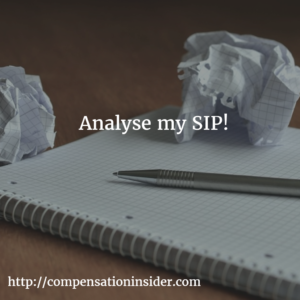My friend took this job at a frozen food company in the Middle East. About one month on the job, he called me and said : “Sandrine can you help me analyse the Sales Incentive Plan which has been in place for a few years ? The GM wants me to give him some feedback but I never had to manage a SIP before and I don’t know where to start”.
Well, I consider myself to be a good friend 😉 – and given I have never been exposed to the food industry, I thought it would be fun to have a look at the documents and see if I could give him some pointers. It turns out that, whatever the industry, there are always a few things that you can investigate when analysing a Sales Incentive Plan. I will cover two of them in this post.
- Consider the on-target payment
In some Sales Incentive Plans, the on-target bonus amount is the same for all people in the same job, for example : all Business Development Executives have an annual target bonus amount of $10,000. This is quite frequent in the USA for example. The advantage to the company is that it allows for easy cost planning and payout comparison.
However, if your BDEs have a different base salary, it means the target bonus amount will represent a different percentage of their salary. It’s fine if their base is relatively comparable, but if you have some more experienced BDEs with a higher base pay, then their motivation to reach the objectives may not be as strong.
So do have a look into the pay structure and how the on-target bonus is expressed, whether it is a fixed amount or a percentage of base salary.
- Consider the mechanics of the bonus payment
For example, their SIP had an overall trigger which was “The Company will pay the bonus only if the Company results are positive”. Yet there was no description, in any document (overall powerpoint presentation, or detailed plan document containing all the rules), of what “Company results” means. Is it gross profit ? net profit ? achievement of certain revenue targets ? or something else entirely ?
The idea to reserve the right to pay anything only if some overall company results are achieved is actually a good one. However in order to maintain credibility to your SIP, give some transparency and improve trust of your employees in the system, you need to describe the rules in a complete manner so that any ambiguity is removed.
The SIP then proceeds to explain that each person needs to reach a certain overall revenue objective for any bonus payment to be made to him. On top of that, there are 3 categories of frozen food, each of them has a target revenue and target bonus payment, as well as minimum revenue needed to be eligible to any payment on that category.
So if you reach overall revenue but miss on category A for example, you will only receive bonus related to categories B and C. And overall, the Sales Incentive Plan does not provide for any payment for over-achievement of objectives.
What do you do with this information ? Beyond the technicalities of the plan, your role is to understand what message the Plan is really sending to your employees, whether it is on purpose or accidental.
In that case, there is nothing wrong with these provisions, however my feeling is that this company is not really looking at making more revenue, and at implementing a “real” Sales Incentive Plan.
There are 3 hurdles (the minimum achievement required to trigger bonus payment) to the payment of the variable pay : overall company results, then overall revenue results for each sales person, and revenue per category of frozen food. And at the same time there is no provision for over-achievement.
So basically all the plan is geared towards ensuring not to pay employees in case revenue is not reached. The plan is not focused on making more income to the organisation.
Combined with the fact that the on-target bonus amount is the same for all sales employees in the same role, this gives me a hint that this Sales Incentive Plan is possibly a legacy plan ie something inherited from the past.
It was probably implemented at a time when the organisation may have had some trouble reaching target revenue while having relatively high fixed personnel costs. So they introduced the scheme by reducing basic pay, offering more money in variable pay but linked to higher revenue than the one achieved at the time (so that employees feel OK about the reduced basic), and no real opportunity to over-achieve as the company needed to control costs.
As the new HR or C&B Manager, your role is now to check if these assumptions are correct, then challenge your senior management to see if the environment is still the same or whether your organisation now wants to focus on other variables, or try to motivate employees beyond the current target revenue.
There are many other things you should check, such as the effect of paymix, the control rules put in place in order to ensure there is no discrepancy between employee targets and their sales supervisor’s targets, the effect of territory on the size of the objectives, comparison to industry practice and external benchmarking etc.
Yet already if you look into the points mentioned above, you will get a good feel about your Sales Incentive Plan, and will be capable of providing some feedback and ideas to your senior management. With the support of Sales and Marketing, Finance and IT, you can then proceed to an overhaul of your SIP if that’s what your organisation is interested about.
Does this business case help you ? Are you interested in learning more about Sales Incentives, or do you prefer other topics ? Leave a comment to let me know !
Related posts :
- Why amI not on the Sales Incentive Plan ?
- Why the Sales Director has less on-target incentive than the Sales people




Dear Sandrine
Thanks for sharing this great article. So do you generally agree with the concept of having a ‘gateway’ hurdle that triggers any sales bonus payment? This could be a hurdle that is either linked to a specific major incentive criterion such as revenue or a general company performance factor such as business unit profitability. And which kind of hurdle do you personally support in a sales incentive context?
Hi Khaled,
I guess it depends on the type of incentive in place. If it’s a commission incentive with low revenue, high volume targets and very small or no basic pay, I don’t think this would work.
For organisations with sales quotas, I don’t necessarily think that a general hurdle is always required. If the organisation is in a market where forecasting is reliable, then if the quotas are set properly, the payment starts only when achieving a certain minimum objective. You can set that within each quota independently so as to reflect the market strategy for each category of product/service being sold.
So from that standpoint, a general hurdle might not be needed in order to ensure that the company doesn’t pay of a certain output level hasn’t been reached.
Besides, every time you add another metric in a Sales Incentive, you reduce comprehension of the scheme, and potentially also reduce the motivation of the salesforce towards their goals – after all, hurdles are (rightfully) perceived as another obstacle to getting the payout.
Thanks Sandrine!
I agree with your suggestions. At the moment our SIP has four personal target criteria: revenue, profit margins, collections, and sales behaviour, and each criterion is linked to a threshold level of performance that triggers bonus on it, so I think in light of your advice I shouldn’t introduce an overall hurdle so as not to de-incentivise the sales force.
I’m glad you found the article relevant Khalid !